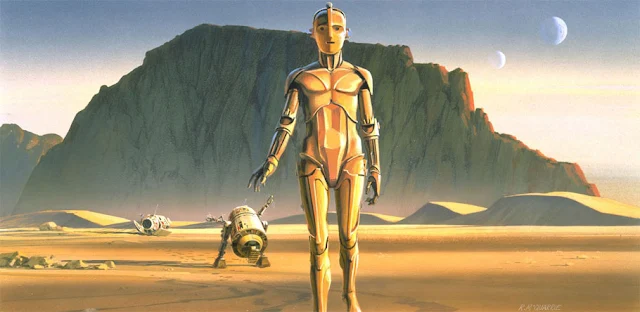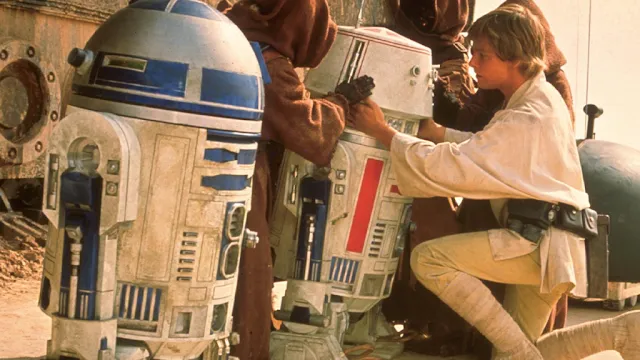Inspired by serialized science fiction such as Flash Gordon and grounded by the mythic structures articulated by Joseph Campbell, Lucas envisioned Star Wars as a cosmic adventure that could captivate audiences with its unique blend of space opera and epic storytelling.
Before Star Wars could become a cultural phenomenon, however, it first needed the backing of a movie studio capable of bringing Lucas's expansive universe to life.
This essay explores the intricate journey Lucas embarked upon to secure this support, focusing particularly on his negotiations with 20th Century Fox.
Lucas’s challenge was not merely to sell a film idea; it was to convince skeptical studio executives to invest in a genre that, at the time, was often considered a risky and unprofitable venture. The negotiation process led to an innovative contract that was highly unusual for the 1970s, significantly granting Lucas the sequel and merchandise rights—a decision that would have profound implications for the film industry and define the modern blockbuster business model.
Lucas’s challenge was not merely to sell a film idea; it was to convince skeptical studio executives to invest in a genre that, at the time, was often considered a risky and unprofitable venture. The negotiation process led to an innovative contract that was highly unusual for the 1970s, significantly granting Lucas the sequel and merchandise rights—a decision that would have profound implications for the film industry and define the modern blockbuster business model.
Early Star Wars Concepts and Pitching the Idea to Hollywood Executives
George Lucas's journey to making Star Wars began long before he approached any studio executives. Initially inspired by the classic space operas and adventure serials of his youth, Lucas aimed to create a modern myth that would offer an escape while imbuing deep, resonant themes that spoke across cultures and ages.The process of refining the concept and preparing his pitch would prove to be a daunting task, one that required not just creativity but an unyielding determination.
Lucas's first inkling of Star Wars came during his work on his previous film, American Graffiti. While American Graffiti was grounded in the nostalgic portrayal of 1960s Americana, Star Wars was to be a stark departure, transporting audiences to a galaxy far, far away. The initial script, then titled "The Star Wars," drew heavily from sources as diverse as the samurai films of Akira Kurosawa, the fantasy of J.R.R. Tolkien, and the fast-paced excitement of World War II air combat films.
Lucas's first inkling of Star Wars came during his work on his previous film, American Graffiti. While American Graffiti was grounded in the nostalgic portrayal of 1960s Americana, Star Wars was to be a stark departure, transporting audiences to a galaxy far, far away. The initial script, then titled "The Star Wars," drew heavily from sources as diverse as the samurai films of Akira Kurosawa, the fantasy of J.R.R. Tolkien, and the fast-paced excitement of World War II air combat films.
These influences blended into a narrative that combined political intrigue, epic battles, and a philosophical dichotomy between good and evil.
As Lucas refined his script, he was also aware of the need to succinctly convey the essence and commercial viability of his project to studio executives. His early pitches were met with skepticism and outright rejection. Science fiction was not seen as a profitable genre in the mid-1970s, perceived as limited to low-budget films with niche audiences. Lucas faced numerous rejections as he sought a studio willing to take a risk on his ambitious project.
The collaboration between Lucas and Ladd Jr. marked a critical turning point in the Star Wars saga. As we will explore in the following sections, this partnership was essential not only in getting the project off the ground but also in navigating the subsequent challenges of production and budgeting. The commitment of 20th Century Fox, spurred by Ladd's support, set the stage for one of the most iconic and influential creations in cinematic history.
Alongside Ladd Jr., there were others within Fox whose reactions to the Star Wars pitch ranged from skeptical to cautiously optimistic.
As Lucas refined his script, he was also aware of the need to succinctly convey the essence and commercial viability of his project to studio executives. His early pitches were met with skepticism and outright rejection. Science fiction was not seen as a profitable genre in the mid-1970s, perceived as limited to low-budget films with niche audiences. Lucas faced numerous rejections as he sought a studio willing to take a risk on his ambitious project.
Finding a Champion in Alan Ladd Jr.
It was not until Lucas pitched his project to Alan Ladd Jr., an executive at 20th Century Fox, that he found a receptive audience. Ladd, unlike his contemporaries, saw potential in Lucas's vision, recognizing the innovative nature of the script and the appeal of the fantastical universe it promised. Ladd’s belief in Lucas's vision was pivotal; he provided not just the initial approval but also the much-needed support within the studio to move the project forward.The collaboration between Lucas and Ladd Jr. marked a critical turning point in the Star Wars saga. As we will explore in the following sections, this partnership was essential not only in getting the project off the ground but also in navigating the subsequent challenges of production and budgeting. The commitment of 20th Century Fox, spurred by Ladd's support, set the stage for one of the most iconic and influential creations in cinematic history.
Alongside Ladd Jr., there were others within Fox whose reactions to the Star Wars pitch ranged from skeptical to cautiously optimistic.
This group included executives like Gordon Stulberg and Dennis Stanfill, the latter of whom was the president of Fox at the time and had a considerable influence on the studio’s strategic decisions. While Stulberg was more hesitant, concerned about the financial risks, Stanfill saw the potential for a significant payoff and ultimately decided to back Ladd Jr.'s judgment.
A pivotal turning point in convincing 20th Century Fox to invest in Star Wars came with the involvement of Ralph McQuarrie, whose visionary concept art provided tangible visuals that captured the essence of George Lucas’s sprawling space saga.
The Role of Ralph McQuarrie’s Concept Art
A pivotal turning point in convincing 20th Century Fox to invest in Star Wars came with the involvement of Ralph McQuarrie, whose visionary concept art provided tangible visuals that captured the essence of George Lucas’s sprawling space saga.
McQuarrie's illustrations were instrumental in helping executives visualize the potential of the project, transforming abstract ideas into compelling images that suggested a cinematic experience unlike any other.

Ralph McQuarrie, an accomplished conceptual designer and illustrator, was brought on board by Lucas to help articulate the filmmaker's vision to both potential backers and the creative team.
McQuarrie’s work encompassed key characters and settings, including iconic images of Darth Vader, C-3PO, and the desert planet of Tatooine. His art not only defined the look and feel of the Star Wars universe but also conveyed its epic scope and the innovative nature of its storytelling.
The persuasive power of McQuarrie’s art extended beyond the initial green-lighting of the project; it also influenced the level of funding and support Lucas received. With tangible illustrations to support the project’s potential, Fox executives were more willing to commit a significant budget to Star Wars.
The persuasive power of McQuarrie’s art extended beyond the initial green-lighting of the project; it also influenced the level of funding and support Lucas received. With tangible illustrations to support the project’s potential, Fox executives were more willing to commit a significant budget to Star Wars.
Negotiating the Contract
The negotiation of the Star Wars contract between George Lucas and 20th Century Fox is a landmark in film history, showcasing not only Lucas's vision but also his astute business acumen. These negotiations set precedents that would influence Hollywood contracts for decades to come.Central to Lucas's negotiations was his insistence on retaining certain rights that were typically relinquished to the studios. He strategically focused on retaining sequel rights and, notably, merchandising rights. At the time, the potential of film merchandise was not fully recognized by major studios, which saw them as mere promotional tools rather than significant revenue streams.
Lucas's foresight to secure these rights would later prove revolutionary, as the Star Wars franchise's extensive merchandising became a major aspect of its legacy and profitability.
To convince Fox to agree to these terms, Lucas made a significant concession: he accepted a lower salary for himself as director in exchange for these lucrative rights.
To convince Fox to agree to these terms, Lucas made a significant concession: he accepted a lower salary for himself as director in exchange for these lucrative rights.
This trade-off was indicative of his confidence in the project's success beyond just box office receipts. The budget negotiated for Star Wars was approximately $11 million, a modest sum by blockbuster standards, which placed Lucas under considerable pressure to deliver a commercially viable film under tight financial constraints.
Despite the support from Alan Ladd Jr. and other Fox executives, Star Wars faced considerable skepticism from within the broader Hollywood community, including doubts about its appeal and its potential to recover the invested capital.
The film industry was uncertain about the viability of advanced science fiction films, which had seen limited success in the past. Additionally, the complex storyline and unusual characters of Star Wars—such as a large, furry Wookiee and a villainous Sith Lord—were far from typical Hollywood fare.
Proving the Concept
Lucas's persistent belief in his vision, supported by McQuarrie's art and ILM's breakthroughs, slowly turned skepticism into anticipation. The innovative promotional campaigns, coupled with early screenings that garnered positive reactions, began to shift perceptions, setting the stage for what would become one of the greatest box office successes in cinema history.
Conclusion
The journey of Star Wars from an ambitious concept to a seminal film that changed the landscape of cinema is a testament to George Lucas's visionary direction, innovative production techniques, and strategic business decisions.
By securing the necessary backing from 20th Century Fox, along with critical rights to sequels and merchandising, Lucas not only created a cultural phenomenon but also redefined the economic model of filmmaking.
The success of Star Wars—commercially, culturally, and critically—highlighted the potential of the sci-fi genre and demonstrated the power of creative vision combined with entrepreneurial acumen. This essay has traced the critical steps and key figures involved in this groundbreaking process, showcasing how Star Wars was not just a film but a pivotal moment in Hollywood history.


















